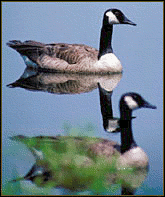|
 

Large, long-necked
goose with dark upperparts and paler underparts grading to white on
vent. The head and neck
are black with white chin bar.
Body is usually gray-brown, although varies from dark brown to gray
in different races. White semi-circle above black tail is visible in
flight.
|
CANADA
GOOSE
Branta canadensis
ANSERIFORMES
Geese and Ducks (Anatidae)
Range
and Habitat
Breeds from Alaska east to Baffin Island and south to California, Illinois,
and Massachusetts. Spends winters south to northern Mexico and the Gulf
coast.; also a widespread resident in city parks and on reservoirs.
Preferred habitats include lakes, bays, rivers, marshes, and stubble
fields.
SOUND: "cackle" or "honk-a-lonk"
At least 11 subspecies of Canada Goose have been recognized and as of
2004 some of the smaller subspecies were designated their own species—the
Cackling Goose.
While their eggs are incubating females lose their flight feathers,
so they cannot fly until after their eggs hatch.
Researchers have identified about 13 different calls from Canada Geese.
These vary including loud greeting/alarm calls and soft sounds from
feeding geese.
A group of geese has many collective nouns, including a "blizzard",
"chevron", "knot", "plump", and "string"
of geese.
The Canada Goose is native to several countries other than Canada and
has been introduced to several others. Prior to 2006, this bird species
was not recognized. It is now currently evaluated as Least Concern.
The breeding range of this bird is fairly large, covering portions of
the northern United States and the Canadian tundra. It winters in southern
North America. The population of this bird is estimated to be around
10 million individual birds. Hunting is a threat and has reduced the
population, but not enough for there to be imminent concern.

|